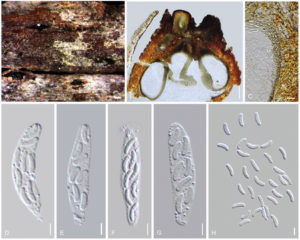Cytospora quercicola Senan., Camporesi, & K.D. Hyde, sp. nov., MycoBank: MB821570
Etymology: Named after the host genus Quercus.
Saprobic on dead branch of Quercus sp. Stromata poorly developed, spread around the papilla, black. Ascomata 550–725 μm high, 160–215 μm diam (x̅ = 611 × 190 μm, n = 20), scattered, aggregated, immersed, globose to subglobose, dark brown, coriaceous, ostiolate, papillate. Papilla 285–430 μm high, 90–130 μm diam (x̅ = 340 × 101 μm, n = 20), long, central or asymmetrically located, papilla close to each other when open to host surface. Peridium comprises brown, thick-walled cells of textura angularis. Asci 75–85 × 15–19 μm (x̅ = 79 × 18 μm, n = 20), 8-spored, unitunicate, clavate to fusiform, without apical ring and pedicel. Ascospores 16–20 × 4–6 μm (x̅ = 17 × 5 μm, n = 20), biseriate, allantoid, hyaline, smooth.
Culture characteristics: Colonies growing on MEA becoming 1 cm within 7 d incubated at 18 °C, circular, flat, smooth colony with white mycelium, mycelia loosely attached to the substrate. Specimen(s) examined: Italy, Province of Forlì-Cesena, Santa Sofia, near Camposonaldo, on dead branch of Quercus sp. (Fagaceae), 10 Dec. 2013, E. Camporesi, IT 1568 (holotype MFLU 17-0881, isotype BBH 42443, culture extype MFLUCC 14-0867).
Notes: The Cytospora quercicola clade is fully-supported by the multi-gene phylogenetic analyses (Clade 16). This species is sister to Cytospora junipericola.
Fig. Cytospora quercicola (MFLU 17–0881). A. Ascomata on substrate. B. Cross section of ascoma. C. Peridium. D–G. Asci. H. Ascospores. Scale bars: A = 200 mm, B = 100 mm, C = 20 mm, D–H = 10 mm.

